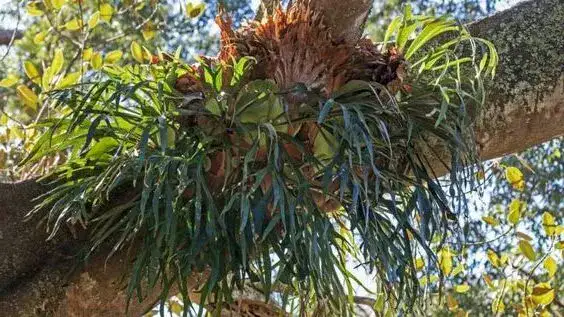Platycerium bifurcatum, commonly known as the elkhorn fern or staghorn fern, possesses unique characteristics that make it a captivating addition to any plant collection. This species of fern is native to Java, New Guinea, and eastern Australia, thriving in rainforest environments. With heart-shaped sterile fronds and arching grey-green fertile fronds that are forked and strap-shaped, Platycerium bifurcatum can grow up to 90 cm tall and 80 cm broad.
Caring for Platycerium bifurcatum requires attention to specific needs. Watering is an essential aspect of their care routine. During dry and hot periods, watering once per week is recommended; however, during cooler months, watering every one to two weeks will suffice. Rainfall or occasional light sprays from a garden hose outdoors provide the necessary moisture for these plants as they primarily absorb water through their foliar and basal fronds.
In terms of lighting requirements, Platycerium bifurcatum thrives when provided with bright but indirect light indoors. Placing them near east or west-facing windows where they receive filtered sunlight ensures optimal growth conditions. If natural sunlight is limited indoors, using a grow light can be beneficial for their development.
Maintaining an ideal temperature range between 60-80°F promotes healthy growth for these ferns. While this temperature range is relatively easy to maintain indoors, precautions should be taken if placed outdoors during colder weather conditions by moving them inside before temperatures drop into the 50’s Fahrenheit. In cases where bringing them indoors may not be feasible due to size constraints, covering them with a sheet or blanket offers protection against mild freezes.
Fertilization requirements for Platycerium bifurcatum are minimal compared to other plants. Monthly application of balanced water-soluble fertilizer during the growing season (spring and summer) provides sufficient nourishment for these ferns. This infrequent fertilization schedule ensures their health and vitality without overwhelming them with excessive nutrients.
Platycerium bifurcatum can be propagated either through spores or by dividing a mature plant into two halves, as long as both halves have enough fronds and roots. While propagating from spores is possible, it requires considerable time and effort, leading many gardeners to opt for other methods. During the summer months, spores can be found on the underside of foliar fronds for those interested in attempting this propagation technique.

Unique Characteristics of Platycerium Bifurcatum
Platycerium bifurcatum is a popular choice among staghorn fern enthusiasts due to its ease of care and unique characteristics. With proper watering, lighting conditions, temperature management, and occasional fertilization, these plants thrive both indoors and outdoors. Whether used as an eye-catching addition to home decor or incorporated into landscaping projects, Platycerium bifurcatum adds natural beauty wherever it is placed.
• Platycerium bifurcatum, commonly known as the elkhorn fern or staghorn fern, is native to Java, New Guinea, and eastern Australia.
• It has heart-shaped sterile fronds and arching grey-green fertile fronds that are forked and strap-shaped.
• The plant can grow up to 90 cm tall and 80 cm broad.
• Watering once per week during dry and hot periods is recommended for Platycerium bifurcatum. During cooler months, watering every one to two weeks will suffice.
• These plants primarily absorb water through their foliar and basal fronds, so occasional light sprays from a garden hose outdoors or rainfall provide necessary moisture.
• Platycerium bifurcatum thrives when provided with bright but indirect light indoors. Placing them near east or west-facing windows with filtered sunlight ensures optimal growth conditions.
• If natural sunlight is limited indoors, using a grow light can be beneficial for their development.
• Maintaining an ideal temperature range between 60-80°F promotes healthy growth for these ferns. Precautions should be taken if placed outdoors during colder weather conditions by moving them inside before temperatures drop into the 50’s Fahrenheit. Covering them with a sheet or blanket offers protection against mild freezes if bringing them indoors is not feasible due to size constraints.
• Monthly application of balanced water-soluble fertilizer during the growing season (spring and summer) provides sufficient nourishment for these ferns. This infrequent fertilization schedule ensures their health without overwhelming them with excessive nutrients.
• Propagation of Platycerium bifurcatum can be done through spores or by dividing a mature plant into two halves as long as both halves have enough fronds and roots.
• While propagating from spores requires time and effort, it can be attempted during the summer months when spores are found on the underside of foliar fronds.
• Platycerium bifurcatum is a popular choice among staghorn fern enthusiasts due to its ease of care and unique characteristics.
• With proper care, these plants thrive both indoors and outdoors, adding natural beauty to home decor or landscaping projects.
The Natural Habitat and Distribution of Platycerium Bifurcatum
Platycerium bifurcatum, also known as the elkhorn fern or common staghorn fern, is a species of fern that can be found in various regions including Java, New Guinea, and eastern Australia. In Australia, it specifically grows in New South Wales, Queensland, and on Lord Howe Island. This unique plant is a bracket epiphyte that thrives in and near rainforests.
Growing up to 90 cm tall by 80 cm broad, Platycerium bifurcatum has heart-shaped sterile fronds measuring 12-45 cm long. It also possesses arching grey-green fertile fronds that are forked and strap-shaped with lengths of up to 90 cm. When caring for this stunning plant indoors or outdoors, it’s important to keep certain factors in mind.
Watering is an essential aspect of Platycerium bifurcatum care. During dry and hot periods of the year, watering once per week is recommended while cooler months may require watering every one to two weeks. Rainfall or occasional light sprays from a garden hose are sufficient for providing necessary moisture as this plant primarily absorbs water through its foliar and basal fronds.
In terms of lighting requirements for indoor growth, bright indirect light is ideal for Platycerium bifurcatum. Placing the plant near an east or west-facing window where sunlight can be filtered works well. If natural sunlight isn’t available at home, using grow lights can provide suitable alternatives for optimal growth results. Additionally maintaining temperatures between 60-80°F ensures successful cultivation both indoors and outdoors.
Propagation techniques for growing your own Platycerium bifurcatum include spores or cutting the full plant in half with a serrated knife if there are enough fronds and roots on both halves. While propagating from spores requires more time investment than other methods such as division or offsets planting; it can be done by collecting spores from the underside of foliar fronds during summer. Platycerium bifurcatum is a popular choice for staghorn fern beginners due to its ease of care and maintenance compared to other species in the Platycerium genus.
Overall, understanding the natural habitat and distribution of Platycerium bifurcatum is crucial for successfully caring for this unique plant. With proper watering, light exposure, temperature control, and propagation techniques, anyone can enjoy the beauty and elegance that this fern brings to both home decor and landscaping projects.
The Life Cycle and Reproduction of Platycerium Bifurcatum
Platycerium bifurcatum, commonly known as the staghorn fern or elkhorn fern, has a fascinating life cycle and reproduction process. This unique plant species can be grown both indoors and outdoors, making it a versatile addition to any home or garden.
The life cycle of Platycerium bifurcatum begins with spores, which are tiny reproductive structures found on the underside of its foliar fronds. In nature, the plant often reproduces through spores. However, growing staghorn ferns from spores can be time-intensive and is not commonly practiced by many gardeners.
Another method of propagation involves cutting a full plant in half with a serrated knife. As long as there are plenty of fronds and roots on both halves, each half can grow into a new individual plant. This method is more popular among gardeners due to its simplicity and efficiency.
When caring for Platycerium bifurcatum during its reproductive stage, it’s important to provide optimal conditions for growth. This includes watering once per week in dry seasons and every one to two weeks during cooler months. The plant primarily absorbs moisture from its foliar and basal fronds.
In terms of light requirements, staghorn ferns thrive in bright but indirect sunlight. Placing them near an east or west-facing window where they receive filtered sunlight is ideal. If natural sunlight is not available indoors, using a grow light can provide the necessary light intensity for healthy growth.
Maintaining an ideal temperature range between 60-80°F (15-27°C) is crucial for successful growth of Platycerium bifurcatum. When temperatures drop below 50°F (10°C), it’s recommended to move the plants indoors or cover them with blankets or sheets to protect them from mild freezes.
Overall, understanding the life cycle and reproduction process of Platycerium bifurcatum is essential for successfully growing and propagating these unique ferns. By providing the right conditions, such as proper watering, light exposure, and temperature control, gardeners can enjoy the beauty of staghorn ferns in their homes or gardens.
The Anatomy and Structure of Platycerium Bifurcatum
Platycerium bifurcatum, commonly known as the elkhorn fern or common staghorn fern, possesses unique characteristics that set it apart from other plants. This species of fern is native to Java, New Guinea, and eastern Australia and can be found in rainforests and their surrounding areas. The plant grows up to 90 cm tall with heart-shaped sterile fronds ranging from 12-45 cm long and arching grey-green fertile fronds that are forked and strap-shaped, reaching lengths of up to 90 cm.
Caring for Platycerium bifurcatum requires attention to specific factors such as watering, light exposure, temperature conditions, and fertilization. Watering should be done once a week during dry periods and every one to two weeks in cooler months. Rainfall or occasional light sprays provide sufficient moisture for the plant’s needs. When it comes to lighting requirements, these ferns thrive in bright indirect light provided by east or west-facing windows indoors. In the absence of natural sunlight, using a grow light yields optimal results. Maintaining an ideal temperature range between 60-80°F ensures healthy growth for this species.
Propagation techniques for growing your own Platycerium bifurcatum include spore propagation or cutting a full plant in half with a serrated knife if there are enough fronds and roots on both halves. While propagating from spores is possible but time-consuming, many gardeners prefer dividing existing plants due to its simplicity. Varieties within the Platycerium genus include Platycerium superbum, Platycerium veitchii, Platycerium hillii,and Platycerium angolense.
In conclusion (without indicating so), caring for this unique plant involves understanding its distinct anatomy and structure while providing appropriate care based on its natural habitat requirements. With proper care techniques like watering schedules tailored to different seasons, adequate light exposure, and temperature control, the elkhorn fern can thrive both indoors and outdoors. Whether used as an eye-catching addition to home decor or a unique landscaping feature, Platycerium bifurcatum adds natural beauty to any setting.

Caring for Platycerium Bifurcatum: Watering, Light, and Temperature Requirements
Watering, light, and temperature requirements are crucial factors to consider when caring for Platycerium bifurcatum. These ferns thrive in specific conditions that mimic their natural habitat. To ensure the health and vitality of your plant, it is essential to understand its unique needs.
When it comes to watering, a good rule of thumb is to water once per week during dry and hot periods, and once every one to two weeks during cooler months. Rainfall or an occasional light spray from the garden hose outdoors is usually sufficient for these plants. It’s important to note that Platycerium bifurcatum primarily absorbs moisture through its foliar and basal fronds.
In terms of lighting requirements, these ferns prefer bright but indirect light. Placing them near east or west-facing windows where they can receive filtered sunlight is ideal. If natural sunlight is not available in your home, using a grow light can provide the necessary illumination for optimal growth.
Maintaining an appropriate temperature range is also vital for the well-being of Platycerium bifurcatum. Ideally, the temperature should be kept between 60-80°F (15-27°C). Indoors, this range can be easily maintained; however, if you have placed your fern outdoors, make sure to bring it inside before temperatures drop below 50°F (10°C). In hotter climates or areas with low humidity levels, regular misting may be required.
While fertilization is not needed frequently for Platycerium bifurcatum’s growth and development process as they absorb nutrients from their environment efficiently , applying a balanced water-soluble fertilizer once a month during the growing season (spring and summer) can help promote healthier foliage.
By understanding these watering practices along with providing adequate lighting conditions and maintaining suitable temperatures according to their needs platycerium bifurcatum diagram , platycerium bifurcatum cura we can ensure the long-term health and vibrancy of our Platycerium bifurcatum ferns. Remember to monitor your plant closely for any signs of distress or disease, as early detection is key to preventing further damage.
Propagation Techniques for Growing Your Own Platycerium Bifurcatum
Propagating Platycerium bifurcatum can be done through spores or by dividing a mature plant. If you choose to propagate from spores, it is important to note that this method requires patience and time. During the summer months, inspect the underside of the foliar fronds to locate the spores. Once you have collected them, prepare a sterile growing medium such as sphagnum moss or a mixture of peat and sand. Sprinkle the spores evenly over the surface of the medium and lightly mist with water. Covering it with plastic wrap will create a humid environment necessary for germination. Keep in mind that this process can take several months before any signs of growth appear.
Another propagation technique involves dividing a mature plant into two halves using a serrated knife. Ensure that both halves have an adequate number of fronds and roots for successful growth. After division, each half should be potted separately in well-draining soil mixtures such as orchid bark or potting soil mixed with perlite or vermiculite. Place them in an area with bright but indirect light and maintain consistent moisture levels until new growth emerges.
When propagating Platycerium bifurcatum cv Alicorne specifically, it is essential to provide optimal conditions for its unique characteristics to thrive successfully. This cultivar has distinct forked and strap-shaped fertile fronds that grow up to 90 cm long, making it visually striking compared to other varieties within the genus.
By following these propagation techniques, you can expand your collection of Platycerium bifurcatum plants while enjoying their beauty and uniqueness at home or in your garden.
Common Pests and Diseases Affecting Platycerium Bifurcatum
Staghorn ferns, specifically Platycerium bifurcatum, are known for their stunning appearance and unique characteristics. However, like any plant, they can be susceptible to certain pests and diseases that can affect their health and growth. It is important for plant enthusiasts to be aware of these common issues in order to properly care for their staghorn ferns.
One common pest that can affect Platycerium bifurcatum is the scale insect. These small insects attach themselves to the fronds of the fern and feed on its sap, causing damage and weakening the plant over time. To combat this issue, it is recommended to regularly inspect the fronds for any signs of infestation and gently remove any visible scales with a soft brush or cloth. Additionally, applying an organic insecticidal soap or neem oil spray can help control scale populations.
Another potential problem for staghorn ferns is fungal infections, such as root rot or leaf spot disease. These conditions often occur when the plant’s roots are consistently exposed to excessive moisture or if there is poor air circulation around the fronds. To prevent fungal infections, it is crucial to provide adequate drainage for your staghorn fern by using well-draining soil mixtures and ensuring that water does not accumulate in the pot or mounting board. If you notice any signs of infection, such as yellowing leaves or black spots on fronds, it may be necessary to treat with a fungicide specifically formulated for ornamental plants.
While these are some common pests and diseases that may affect Platycerium bifurcatum staghorn ferns, it’s important to note that proper care practices including regular watering schedules (avoiding overwatering), providing sufficient light levels (bright indirect light), maintaining appropriate temperatures (60-80°F), and avoiding overcrowding among other plants will greatly reduce susceptibility.
By understanding these potential issues and taking proactive measures to prevent and treat them, plant enthusiasts can ensure the health and longevity of their Platycerium bifurcatum staghorn ferns. With proper care, these unique plants will continue to thrive and add a touch of natural beauty to any home or garden setting.
Creative Uses of Platycerium Bifurcatum in Home Decor and Landscaping
Platycerium bifurcatum, also known as the elkhorn fern or common staghorn fern, is a versatile plant that can be used creatively in home decor and landscaping. Its unique characteristics make it an attractive addition to any space.
In home decor, Platycerium bifurcatum can be mounted on walls or displayed in hanging baskets to create a striking focal point. Its large, arching fronds add a touch of natural beauty and elegance to any room. The heart-shaped sterile fronds provide a soft and delicate texture, while the forked and strap-shaped fertile fronds add visual interest with their grey-green coloration.
For landscaping purposes, Platycerium bifurcatum can be used to create stunning vertical gardens or living walls. Its ability to grow as an epiphyte allows it to thrive on tree trunks or other vertical surfaces without the need for soil. This makes it ideal for adding greenery to small spaces or urban environments where traditional gardening may not be feasible.
Additionally, Platycerium bifurcatum can be incorporated into outdoor landscapes by planting them in shaded areas under trees or along garden paths. Their unique growth habit adds depth and dimension to the landscape while providing a natural habitat for beneficial insects and wildlife.
Overall, the creative uses of Platycerium bifurcatum in home decor and landscaping are endless. Whether indoors or outdoors, this beautiful fern species brings a sense of tranquility and connection with nature wherever it is placed.

Conservation Efforts and Importance of Preserving Platycerium Bifurcatum’s Natural Habitat
Conservation efforts for Platycerium bifurcatum, also known as the elkhorn fern or common staghorn fern, are crucial in preserving its natural habitat. This species of fern is native to Java, New Guinea, and eastern Australia and plays a significant role in the ecosystems it inhabits. The unique characteristics of Platycerium bifurcatum make it an important part of biodiversity conservation.
One key aspect of conserving Platycerium bifurcatum’s natural habitat is protecting the rainforests where it grows. These forests provide the ideal conditions for this fern to thrive, with their high humidity and shade. Deforestation poses a significant threat to these habitats, leading to the loss of not only Platycerium bifurcatum but also many other plant and animal species that depend on these forests for survival. Conservation efforts should focus on promoting sustainable forestry practices and raising awareness about the importance of preserving these valuable ecosystems.
Another important conservation effort is preventing illegal collection and trade of Platycerium bifurcatum. Due to its unique appearance and popularity among plant enthusiasts, there is a demand for this fern in the horticultural market. However, unsustainable harvesting can lead to population decline and even extinction in certain areas. Implementing regulations against illegal collection and encouraging responsible sourcing practices can help protect wild populations from overexploitation.
Furthermore, education plays a vital role in conservation efforts for Platycerium bifurcatum’s natural habitat. By raising awareness about the ecological significance of this fern and its role in maintaining healthy ecosystems, individuals can be encouraged to take action towards preservation. Educating communities living near these habitats about sustainable land use practices can also contribute to long-term conservation goals.
Conserving Platycerium bifurcatum’s natural habitat requires collective efforts from governments, organizations, communities, and individuals alike. By protecting rainforests, preventing illegal trade, and promoting education, we can ensure the survival of this unique fern species for future generations. Preserving Platycerium bifurcatum’s natural habitat is not only essential for its own sake but also for maintaining the overall biodiversity and ecological balance of our planet.
FAQs about Platycerium Bifurcatum
What are the unique characteristics of Platycerium Bifurcatum?
Platycerium Bifurcatum, also known as the Staghorn Fern, has several unique characteristics. It has distinctive antler-like fronds that give it its name, and it is an epiphytic plant, meaning it grows on other plants without harming them. It also has a unique root system that is used to attach itself to trees or other surfaces.
Where can Platycerium Bifurcatum be found in its natural habitat?
Platycerium Bifurcatum is native to tropical and subtropical regions, particularly in Southeast Asia, Australia, and Africa. It can be found growing on trees in rainforests, as well as in rocky or mossy areas.
How does Platycerium Bifurcatum reproduce?
Platycerium Bifurcatum reproduces through spores, which are produced on the undersides of the fronds. These spores are released into the air and can be carried by wind or water to find suitable growing conditions.
What is the anatomy and structure of Platycerium Bifurcatum?
Platycerium Bifurcatum has two main types of fronds: sterile fronds and fertile fronds. Sterile fronds are the larger, flat fronds that give the plant its distinctive appearance. Fertile fronds are smaller and cup-shaped, and they produce spores for reproduction. The plant also has a rhizome, which is a horizontal stem that anchors it to its host.
How should I care for Platycerium Bifurcatum in terms of watering, light, and temperature requirements?
Platycerium Bifurcatum prefers indirect light and should be placed in a bright but shaded area. It requires regular watering to keep the soil moist but not waterlogged. Additionally, it thrives in temperatures between 60°F and 80°F (15°C to 27°C), with higher humidity levels.
What are the propagation techniques for growing my own Platycerium Bifurcatum?
Propagating Platycerium Bifurcatum can be done through division or by using spores. When dividing the plant, carefully separate the rhizomes and attach them to a suitable surface. To grow from spores, collect them from the fertile fronds and sow them onto a well-draining medium.
What are the common pests and diseases that affect Platycerium Bifurcatum?
Platycerium Bifurcatum can be susceptible to mealybugs, scale insects, and spider mites. It can also be affected by fungal diseases if the plant is overwatered or exposed to high humidity for an extended period. Regular inspection and maintaining proper care can help prevent and manage these issues.
How can I creatively use Platycerium Bifurcatum in home decor and landscaping?
Platycerium Bifurcatum can be an excellent addition to home decor, as it can be mounted on walls, displayed in hanging baskets, or showcased in terrariums. In landscaping, it can be used to create vertical gardens, add texture to rock gardens, or enhance outdoor spaces with its unique foliage.
Why is it important to preserve the natural habitat of Platycerium Bifurcatum?
Preserving the natural habitat of Platycerium Bifurcatum is crucial for the long-term survival of the species and maintaining biodiversity. By protecting its natural habitat, we ensure the continued existence of this unique fern and the ecosystems it supports.
Are there any conservation efforts in place for Platycerium Bifurcatum?
Yes, there are conservation efforts in place for Platycerium Bifurcatum. These efforts focus on preserving its natural habitat, raising awareness about the importance of the species, and promoting sustainable cultivation practices. Conservation organizations and botanical gardens often play a key role in these efforts.













Comments are closed.